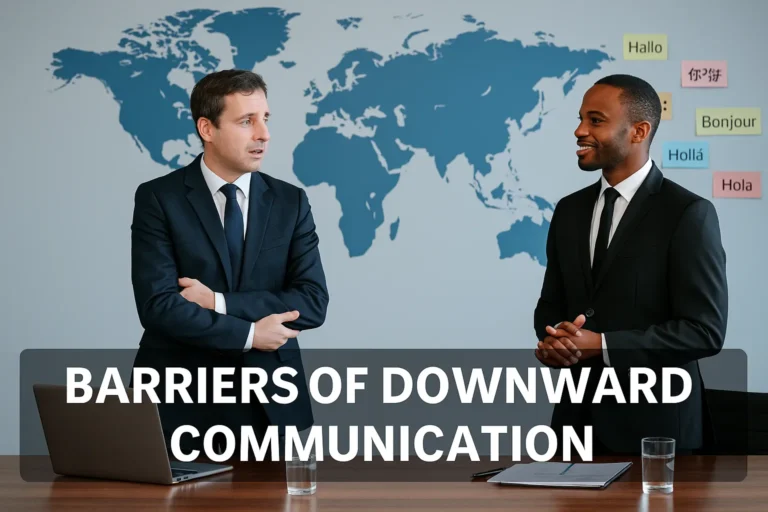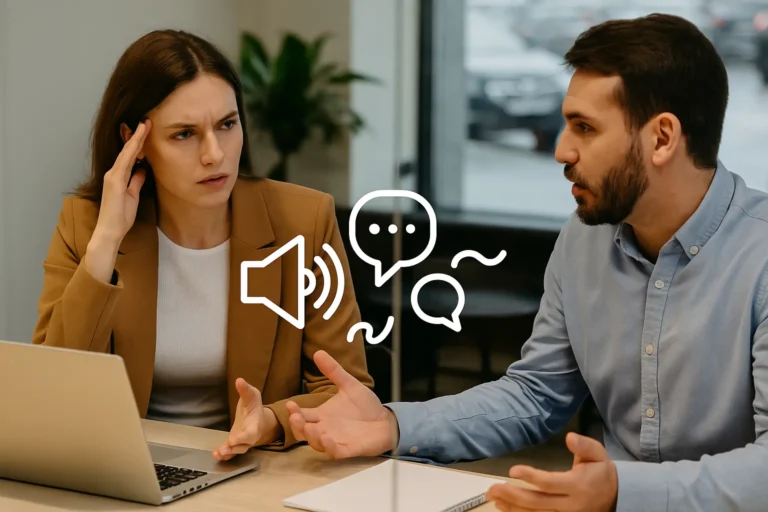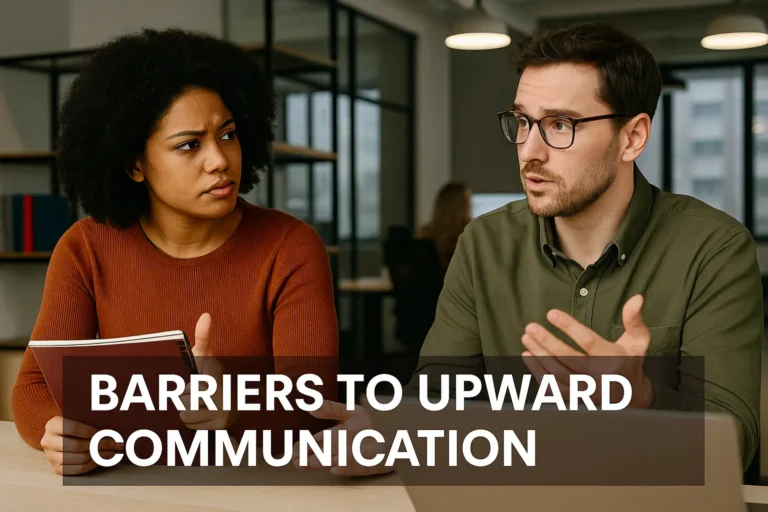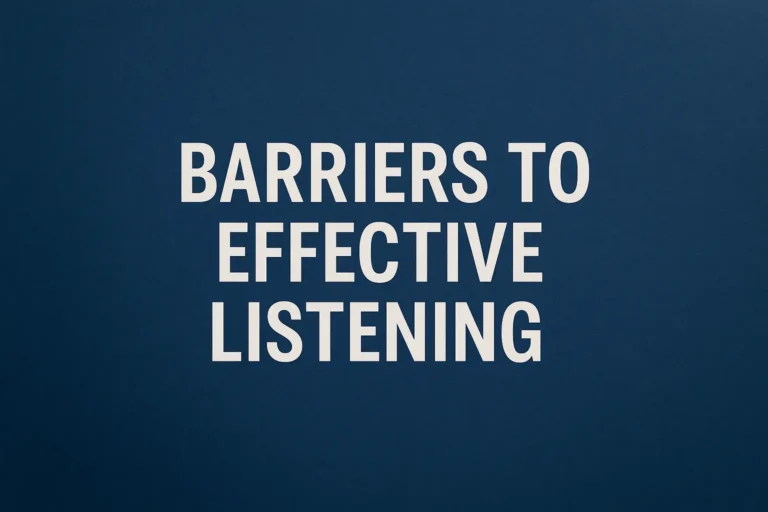Barriers to Nonverbal Communication
Have you ever left a meeting feeling confused by a colleague’s body language, or misread someone’s reaction even though their words seemed clear? Barriers to nonverbal communication can leave people feeling disconnected, frustrated, or misunderstood—at work, in social life, or at home. While most people focus on what is said, how it’s said often speaks louder. The challenge is, nonverbal messages can get blocked, misread, or lost, making true understanding difficult.
Recognizing these silent obstacles is the first step to building better connections. This guide takes you through the key types of nonverbal barriers, why they matter, and—most importantly—practical ways to overcome them for clearer, kinder, and more successful communication.
What Is Nonverbal Communication?
Nonverbal communication is everything we share without words. It’s how we express feelings, show respect, or signal discomfort—often without realizing it. This includes:
- Facial expressions: Smiles, frowns, raised eyebrows.
- Gestures: Hand movements, nods, waves, thumbs up.
- Body language and posture: Sitting upright, slouching, crossed arms.
- Eye contact (oculesics): Looking directly, avoiding gaze, blinking.
- Physical space (proxemics): Personal distance, physical boundaries.
- Touch (haptics): Handshakes, pats on the back.
- Time (chronemics): Punctuality, waiting, response times.
- Paralanguage: Tone, pitch, speed, pauses in speech.
- Appearance: Clothing, grooming, accessories.
Whether you’re at a job interview, talking with friends, or video chatting with family, these cues shape how your message is received. In fact, research shows most of what we communicate is nonverbal!
Major Barriers to Nonverbal Communication
Despite its importance, nonverbal communication is often misunderstood or blocked by hidden obstacles. Let’s look at the most common barriers.
Cultural Barriers

Culture is one of the biggest influences on nonverbal signals. What’s polite in one culture may be offensive in another. Consider:
- Gestures: The “OK” sign means “fine” in the US, but can be rude in Brazil.
- Eye contact: Direct eye contact signals confidence in Western countries but can be seen as disrespectful elsewhere.
- Space and touch: Some cultures value personal space, while others are comfortable standing close.
- Time: Being late may be disrespectful in some countries and perfectly normal in others.
Misreading these cues can lead to embarrassment or hurt feelings. For example, a manager from Germany might value punctuality and direct feedback, while a team member from India may prefer a softer approach and more flexible timing.
Physical, Environmental, and Contextual Barriers
Where and how you communicate affects nonverbal signals. Physical and environmental factors can block or distort your message, such as:
- Distance: Too much space can feel cold; too little can be intimidating.
- Room layout: Cubicles, barriers, or screens block body language.
- Lighting and noise: Poor lighting hides facial cues, while noise can drown out tone or emphasis.
- Personal protective equipment (PPE): Masks and gloves, common in healthcare, make it hard to read lips, see smiles, or offer comforting touch.
- Disabilities: Visual, hearing, or mobility impairments may make it harder to send or receive nonverbal messages.
Even the formality of a setting—like a courtroom vs. a family dinner—changes what nonverbal signals are expected or allowed.
Psychological and Emotional Barriers
Feelings shape how we send and interpret nonverbal cues. When people are stressed, anxious, angry, or distracted, their body language can shift. Emotional barriers include:
- Stress and anxiety: Tension may show as fidgeting, avoiding eye contact, or stiff posture.
- Anger or sadness: Crossed arms, slumped shoulders, or a flat tone can signal upset—even when words don’t.
- Bias and stereotypes: Prejudgments about people affect how their gestures are read.
- Lack of confidence: Someone who’s shy or self-conscious might avoid eye contact, speak softly, or fidget.
If your mood is off, your body language might send the wrong message—or you might misread someone else’s cues.
Semantic and Congruence Barriers
Sometimes words and body language don’t match. If someone says “I’m fine” but rolls their eyes, the mixed signal creates confusion. Common problems include:
- Mixed signals: Verbal and nonverbal messages don’t align, making it unclear what’s really meant.
- Nonverbal leakage: When feelings “leak” through gestures even if we try to hide them.
- Ambiguity: Some gestures are vague and can mean different things in different contexts.
Learning to spot these mismatches—and clarify their meaning—helps avoid misunderstandings.
Feedback and Interpretation Barriers
Feedback is vital in communication, but it’s easy to miss in nonverbal exchanges. Problems include:
- Lack of feedback: No chance to check if a gesture or look was understood.
- Meta-communication: Not talking about communication (“Did I come across as upset?”).
- Personal interpretation: Each person reads signals through their own lens, which can cause misreading.
Without feedback, simple gestures can get lost or misinterpreted.
Digital and Technological Barriers

Technology adds new challenges to reading nonverbal cues. Common issues:
- Video calls: Camera angles, lighting, or poor quality can obscure gestures and facial expressions.
- Text messages: No tone, body language, or facial cues. Emojis help, but often aren’t enough.
- Technical glitches: Lag or dropped calls make it hard to read timing or responses.
- AI and avatars: Chatbots or virtual assistants can’t send or read human nonverbal signals effectively.
Choosing the right channel and adapting your cues to digital spaces is more important than ever.
Personal Style, Generational, and Gender Differences
How you express yourself is shaped by personality, age, and gender. For example:
- Expressive vs. reserved: Some people are naturally animated; others are subtle.
- Generational: Younger people may use emojis or gestures differently from older colleagues.
- Gender: Cultural norms about eye contact, touch, or posture often differ by gender.
These differences can lead to misunderstanding, especially in diverse teams.
Special Considerations
Certain groups face extra barriers with nonverbal communication. This includes:
- Neurodivergence: People with autism spectrum disorder, ADHD, or anxiety may interpret or express nonverbal cues differently.
- Intersectionality: Overlapping identities (race, culture, disability) shape experiences and expectations.
- High-stress situations: In emergencies, cues are more likely to be misread or ignored.
Recognizing and respecting these differences is key to inclusive communication.
Real-World Examples and Case Studies
- Multicultural workplaces: An international team struggles with meetings because team members from different backgrounds misread gestures or tone.
- Healthcare settings: A nurse wearing a mask can’t smile to reassure a nervous patient, leading to increased anxiety.
- Remote work: On a video call, a manager’s stiff posture is read as disinterest, though they’re just focusing on the screen.
- Crisis situations: During an emergency, a team member’s urgent tone and gestures are missed due to noise and stress.
These examples show how common and costly nonverbal misunderstandings can be.
Strategies to Overcome Barriers to Nonverbal Communication
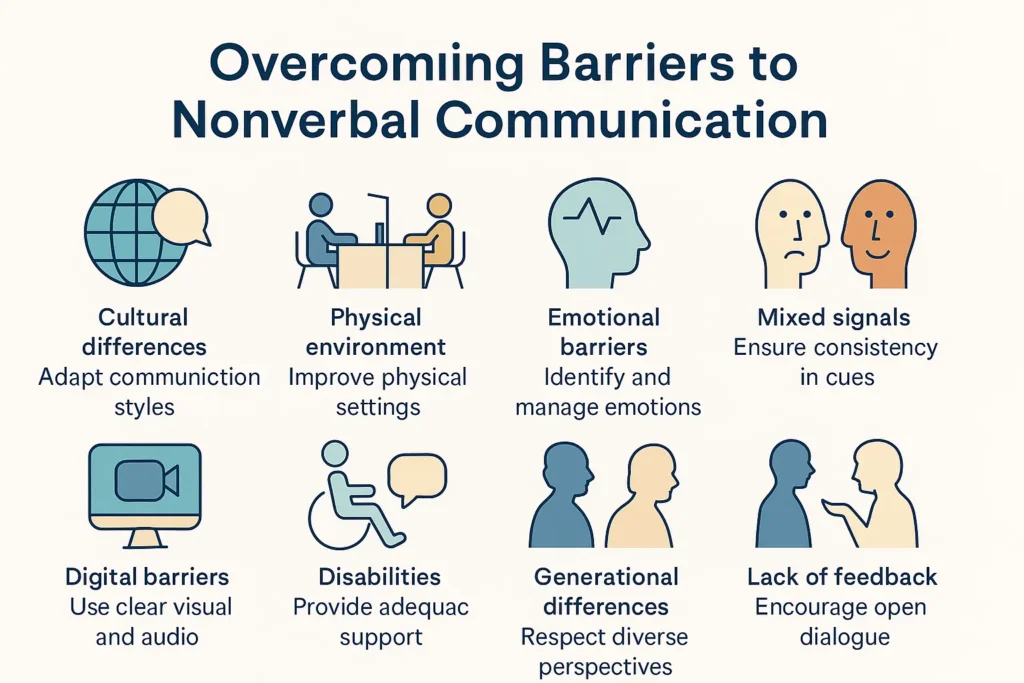
Don’t worry—most barriers can be reduced with practical steps. Here’s how:
Build Self-Awareness and Seek Feedback
- Watch your own gestures, tone, and posture.
- Ask others if your signals are clear.
- Practice in front of a mirror or record yourself.
Learn About Cultural Differences
- Attend workshops or training on intercultural skills.
- Read up on different customs.
- When unsure, ask respectful questions or observe before acting.
3. Use Clear and Consistent Signals
- Make sure your words and body language match.
- Use open gestures, nodding, and positive facial expressions.
- Avoid ambiguous gestures in cross-cultural or digital settings.
Practice Active Listening and Clarification
- Watch for nonverbal cues from others and check understanding.
- Repeat or paraphrase what you see and hear: “You seem concerned—did I get that right?”
- Invite questions and feedback.
Adapt for Digital Settings
- Use good lighting and look into the camera during video calls.
- Be expressive with your face and voice to compensate for what’s missing.
- Summarize key points in writing after meetings.
Be Inclusive for Disabilities
- Use visual supports, captions, or sign language when possible.
- Face the person you’re speaking to.
- Check accessibility in digital platforms.
Manage Emotions and Build Emotional Intelligence
- Pause before reacting if you’re upset or anxious.
- Learn stress-reduction techniques like breathing or mindfulness.
- Reflect on your triggers and practice calm responses.
Encourage Feedback and Checking for Understanding
- Create a culture where people can ask, clarify, or point out confusion.
- Use feedback forms, surveys, or open discussion.
Invest in Training and Continuous Learning
- Join workshops or courses on communication skills.
- Encourage team-building activities that focus on nonverbal cues.
| Barrier Type | Example | Solution |
|---|---|---|
| Cultural | Misread gestures in global teams | Cultural training, ask/observe first |
| Physical/Environmental | Poor lighting hides expressions | Adjust room, improve visibility |
| Psychological/Emotional | Stress causes closed-off body language | Pause, relax, self-reflection |
| Semantic/Congruence | Saying “yes” but shaking head “no” | Practice matching signals |
| Feedback/Interpretation | No chance to check understanding | Ask, paraphrase, feedback |
| Digital/Technological | Video call misses facial cues | Look at camera, use written follow-up |
| Personal Style/Generational | Reserved person misunderstood as unfriendly | Discuss style, invite input |
| Special Considerations | Neurodivergent team member misreads signals | Training, patience, clarify intentions |
Conclusion
Barriers to nonverbal communication can quietly break down relationships and trust, but you can overcome them. Clear nonverbal signals, active listening, and cultural awareness are essential for connecting in a diverse, modern world. When you spot these silent obstacles and address them with care, you open the door to genuine understanding and better teamwork. Take the time to notice, learn, and practice—you’ll see the difference in every area of life.

